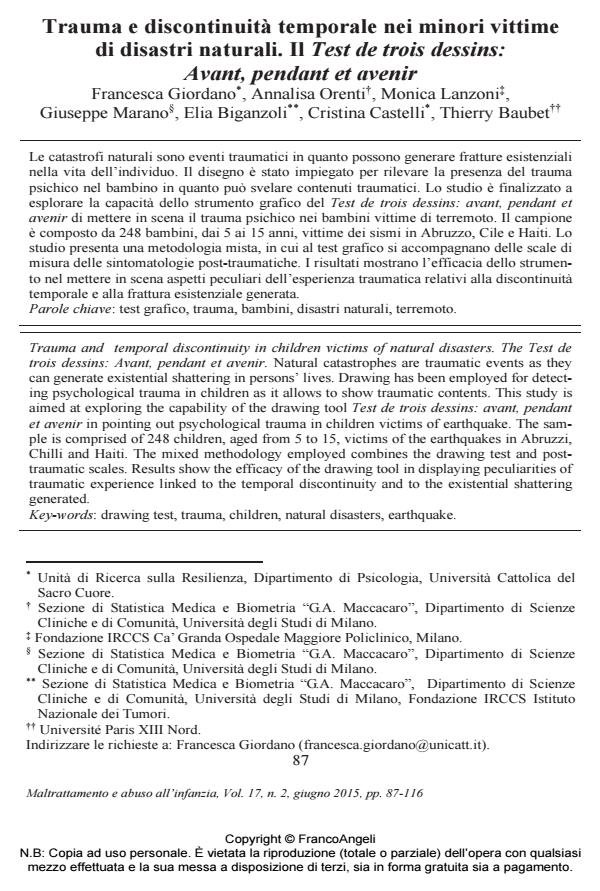Trauma e discontinuità temporale nei minori vittime di disastri naturali. Il Test de trois dessins: Avant, pendant et avenir
Titolo Rivista MALTRATTAMENTO E ABUSO ALL’INFANZIA
Autori/Curatori Francesca Giordano, Annalisa Orenti, Monica Lanzoni, Giuseppe Marano, Elia Biganzoli, Cristina Castelli, Thierry Baubet
Anno di pubblicazione 2015 Fascicolo 2015/2
Lingua Italiano Numero pagine 30 P. 87-116 Dimensione file 172 KB
DOI 10.3280/MAL2015-002005
Il DOI è il codice a barre della proprietà intellettuale: per saperne di più
clicca qui
Qui sotto puoi vedere in anteprima la prima pagina di questo articolo.
Se questo articolo ti interessa, lo puoi acquistare (e scaricare in formato pdf) seguendo le facili indicazioni per acquistare il download credit. Acquista Download Credits per scaricare questo Articolo in formato PDF

FrancoAngeli è membro della Publishers International Linking Association, Inc (PILA)associazione indipendente e non profit per facilitare (attraverso i servizi tecnologici implementati da CrossRef.org) l’accesso degli studiosi ai contenuti digitali nelle pubblicazioni professionali e scientifiche
Le catastrofi naturali sono eventi traumatici in quanto possono generare fratture esistenziali nella vita dell’individuo. Il disegno è stato impiegato per rilevare la presenza del trauma psichico nel bambino in quanto può svelare contenuti traumatici. Lo studio è finalizzato a esplorare la capacità dello strumento grafico del Test de trois dessins: avant, pendant et avenir di mettere in scena il trauma psichico nei bambini vittime di terremoto. Il campione è composto da 248 bambini, dai 5 ai 15 anni, vittime dei sismi in Abruzzo, Cile e Haiti. Lo studio presenta una metodologia mista, in cui al test grafico si accompagnano delle scale di misura delle sintomatologie post-traumatiche. I risultati mostrano l’efficacia dello strumento nel mettere in scena aspetti peculiari dell’esperienza traumatica relativi alla discontinuità temporale e alla frattura esistenziale generata.
Parole chiave:Test grafico, trauma, bambini, disastri naturali, terremoto
- Transit Migration and Trauma: the Detrimental Effect of Interpersonal Trauma on Syrian Children in Transit in Italy Francesca Giordano, Alessandra Cipolla, Fausto Ragnoli, Federico Brajda Bruno, in Psychological Injury and Law /2019 pp.76
DOI: 10.1007/s12207-019-09345-x - Children’s representations of the COVID-19 lockdown and pandemic through drawings Alessia Cornaggia, Federica Bianco, Gabriella Gilli, Antonella Marchetti, Davide Massaro, Ilaria Castelli, in Frontiers in Psychology 960893/2022
DOI: 10.3389/fpsyg.2022.960893 - Child Psychological Adjustment to War and Displacement: A Discriminant Analysis of Resilience and Trauma in Syrian Refugee Children Guido Veronese, Alessandro Pepe, Francesca Giordano, in Journal of Child and Family Studies /2021 pp.2575
DOI: 10.1007/s10826-021-02067-2 - Tutor of Resilience: A Model for Psychosocial Care Following Experiences of Adversity Francesca Giordano, Alessandra Cipolla, Michael Ungar, in Frontiers in Psychiatry 559154/2021
DOI: 10.3389/fpsyt.2021.559154 - Social-Ecological Resilience Moderates the Effectiveness of Avoidant Coping in Children Exposed to Adversity: An Exploratory Study in Lithuania Francesca Giordano, Simona C. S. Caravita, Philip Jefferies, in Frontiers in Psychology 536353/2020
DOI: 10.3389/fpsyg.2020.536353 - L'impatto della paura da COVID-19 sui livelli di stress e sui sintomi di ansia e depressione in adolescenti Maria Giuseppina Bartolo, Anna Lisa Palermiti, Rocco Servidio, Flaviana Tenuta, Francesco Craig, Angela Costabile, in MALTRATTAMENTO E ABUSO ALL'INFANZIA 2/2021 pp.47
DOI: 10.3280/MAL2021-002004 - How do children make sense of peace and war? An exploratory study through the drawings of Italian pupils with an indirect experience of the war in Ukraine Alessia Cornaggia, Federica Bianco, Ilaria Castelli, in RICERCHE DI PSICOLOGIA 4/2025 pp.7
DOI: 10.3280/rip2024oa19473
Francesca Giordano, Annalisa Orenti, Monica Lanzoni, Giuseppe Marano, Elia Biganzoli, Cristina Castelli, Thierry Baubet, Trauma e discontinuità temporale nei minori vittime di disastri naturali. Il Test de trois dessins: Avant, pendant et avenir in "MALTRATTAMENTO E ABUSO ALL’INFANZIA" 2/2015, pp 87-116, DOI: 10.3280/MAL2015-002005